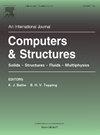Efficient method for dynamic responses, modal and buckling analysis of cylindrical periodic structures based on the group theory and Woodbury formula
IF 4.8
2区 工程技术
Q1 COMPUTER SCIENCE, INTERDISCIPLINARY APPLICATIONS
引用次数: 0
Abstract
This paper proposes an efficient method that combines group theory, the Woodbury formula, and condensation technology to solve the governing equations related to dynamic responses, modal and buckling analysis of cylindrical periodic structures. Efficient and accurate solution of linear algebraic equations is pivotal for dynamic responses, modal and buckling analysis. Based on the cyclic periodic property of the structures and group theory, the linear algebraic equations can be transformed into a series of independent subequations corresponding to one-dimensional (1D) periodic structures. The degrees of freedom (DOFs) of the unit cell corresponding to the 1D periodic structures can be divided into two boundary-surface DOFs and internal DOFs. To reduce the scale of the 1D periodic structures, we use condensation technique to condense the internal DOFs into the two boundary-surface DOFs. Thus, the scales of these subequations can be significantly reduced. Since the coefficient matrices of the small-scale subequations resemble block-circulant matrices, the Woodbury formula is used to obtain their solutions by solving some newly formed linear algebraic equations whose coefficient matrices are block-circulant. These newly formed linear algebraic equations are then efficiently solved using group theory. Numerical examples are presented to confirm the high accuracy and efficiency of the proposed method.
基于群理论和Woodbury公式的圆柱周期结构动力响应、模态和屈曲分析的有效方法
本文提出了一种结合群论、Woodbury公式和凝聚技术求解圆柱周期结构动力响应、模态和屈曲分析等控制方程的有效方法。有效、准确地求解线性代数方程是动力响应、模态和屈曲分析的关键。根据结构的循环周期性质和群论,可以将线性代数方程转化为一系列与一维周期结构相对应的独立子方程。一维周期结构所对应的单元胞的自由度可分为边界面自由度和内部自由度。为了减小一维周期结构的尺度,我们采用缩合技术将内部的自由度压缩为两个边界表面的自由度。因此,这些子方程的尺度可以显著减小。由于小尺度子方程的系数矩阵类似于块循环矩阵,因此,通过求解一些系数矩阵为块循环的新形成的线性代数方程,利用Woodbury公式求得它们的解。然后利用群论有效地求解这些新形成的线性代数方程。数值算例验证了该方法的精度和效率。
本文章由计算机程序翻译,如有差异,请以英文原文为准。
求助全文
约1分钟内获得全文
求助全文
来源期刊

Computers & Structures
工程技术-工程:土木
CiteScore
8.80
自引率
6.40%
发文量
122
审稿时长
33 days
期刊介绍:
Computers & Structures publishes advances in the development and use of computational methods for the solution of problems in engineering and the sciences. The range of appropriate contributions is wide, and includes papers on establishing appropriate mathematical models and their numerical solution in all areas of mechanics. The journal also includes articles that present a substantial review of a field in the topics of the journal.
 求助内容:
求助内容: 应助结果提醒方式:
应助结果提醒方式:


